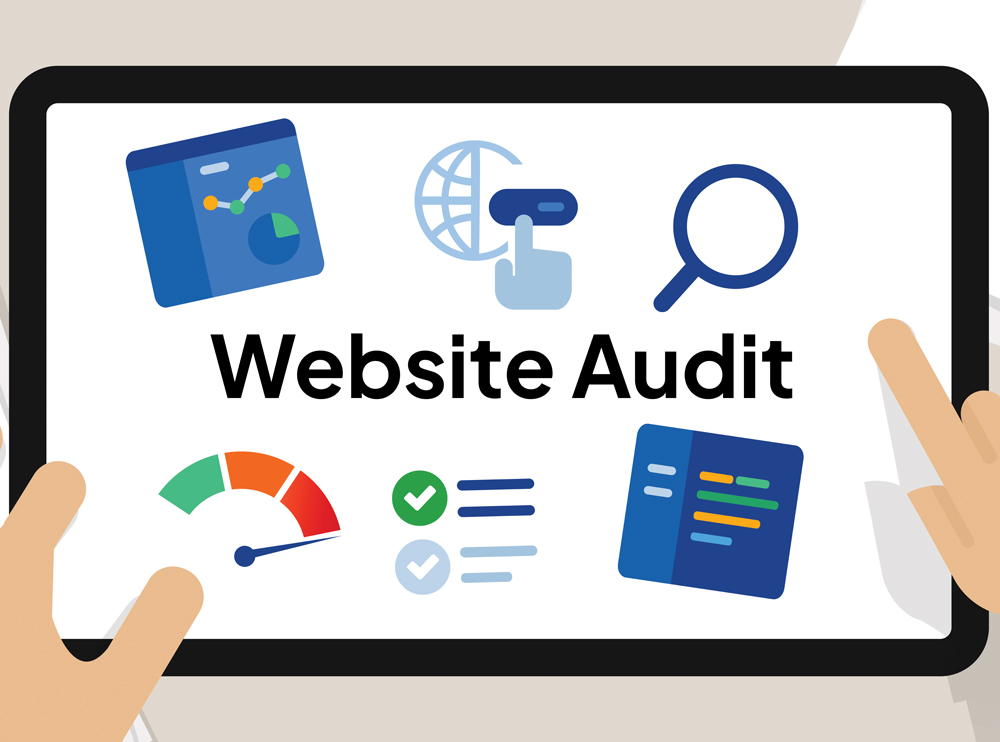Introduction:
A website audit is an essential process for evaluating the performance, structure, and effectiveness of a website. By identifying issues and opportunities for improvement, a thorough audit can enhance your website’s user experience, search engine rankings, and overall functionality. Here is a step-by-step guide to conducting a comprehensive website audit.
Step 1: Define Your Objectives
Before diving into the audit process, it’s crucial to establish clear objectives. Determine what you want to achieve with the audit. Common goals include:
- Improving search engine optimisation (SEO)
- Enhancing user experience (UX)
- Ensuring compliance with accessibility standards
- Increasing website speed and performance
- Identifying and fixing technical issues
Having specific goals will guide your focus during the audit and help prioritise the necessary changes.
Step 2: Assess Website Performance
Website performance impacts both user satisfaction and search engine rankings. Use tools like Google PageSpeed Insights, GTmetrix, or Pingdom to evaluate your website’s speed and responsiveness.
Key Metrics to Review:
- Page Load Time: Aim for load times under 3 seconds
- Core Web Vitals: Focus on metrics like Largest Contentful Paint (LCP), First Input
- Delay (FID), and Cumulative Layout Shift (CLS).
- Server Response Time: Ensure your server is optimised to handle traffic efficiently.
Action Steps:
- Compress images and optimise file sizes.
- Minify CSS, JavaScript, and HTML files.
- Leverage browser caching and a content delivery network (CDN).

Step 3: Conduct a Technical SEO Audit
Technical SEO ensures that search engines can crawl and index your website effectively. Use tools like Screaming Frog, SEMrush, or Ahrefs to analyse your site’s technical aspects.
What to Check:
- Crawlability: Ensure that all important pages are accessible to search engines.
- XML Sitemap: Verify that your sitemap is up-to-date and submitted to search engines.
- Robots.txt File: Confirm that this file isn’t blocking important pages.
- Broken Links: Identify and fix broken internal and external links.
- Canonical Tags: Ensure proper use of canonical tags to prevent duplicate content issues.
Action Steps:
- Fix broken links and redirects.
- Update your robots.txt file if necessary.
- Submit your sitemap through tools like Google Search Console.
Step 4: Evaluate Content Quality
Content plays a critical role in engaging users and driving organic traffic. An audit of your website’s content can identify gaps, redundancies, and opportunities for improvement.
What to Review:
- Relevance: Is the content aligned with your audience’s needs and interests?
- Quality: Is the content well-written, engaging, and free of grammatical errors?
- SEO: Are keywords used effectively without overstuffing?
- Duplication: Check for duplicate content using tools like Copyscape or Siteliner.
- Outdated Information: Update or remove outdated content.
Action Steps:
- Refresh outdated content with current information.
- Use analytics to identify high-performing content and replicate its success.
- Optimise meta titles, descriptions, and headers for target keywords.
Step 5: Analyse User Experience (UX)
A user-friendly website encourages visitors to stay longer and engage with your content. Evaluate your website’s design and functionality from the user’s perspective.
What to Consider:
- Navigation: Is the site easy to navigate? Can users find what they’re looking for quickly?
- Mobile-Friendliness: Ensure your site is responsive and optimised for mobile devices. Use Google’s Mobile-Friendly Test tool to check compatibility.
- Design Consistency: Maintain consistent branding, fonts, and colour schemes throughout the site.
- Call-to-Actions (CTAs): Are CTAs clear, visible, and compelling?
Action Steps:
- Simplify your website’s navigation structure.
- Optimise forms and buttons for mobile users.
- Conduct usability testing to gather real user feedback.
Step 6: Verify Accessibility Compliance
Web accessibility ensures that your website is usable by people with disabilities. This is not only a legal requirement in many jurisdictions but also an ethical responsibility.
Accessibility Checklist:
- Alt Text: Ensure all images have descriptive alt text.
- Keyboard Navigation: Confirm that your website can be navigated using a keyboard.
- Screen Reader Compatibility: Test your site with screen readers like NVDA or JAWS.
- Contrast Ratios: Ensure sufficient contrast between text and background colours.
Action Steps:
- Use tools like WAVE or Axe to identify accessibility issues.
- Follow the Web Content Accessibility Guidelines (WCAG).
- Regularly test your site for accessibility compliance.

Step 7: Audit Your Website’s Backlink Profile
Backlinks remain a key factor in SEO rankings. Analysing your backlink profile helps identify opportunities to improve your site’s authority and eliminate harmful links.
What to Review:
- Quality of Links: Focus on acquiring backlinks from high-authority, relevant sites.
- Toxic Links: Identify and disavow spammy or harmful backlinks.
- Anchor Text Distribution: Ensure anchor texts are varied and natural.
Action Steps:
- Use tools like Ahrefs, SEMrush, or Moz to analyse your backlinks.
- Reach out to websites for guest posting opportunities.
- Disavow harmful links using Google’s Disavow Tool.
Step 8: Test Website Security
Security is critical to protect your website from cyber threats and build user trust. Regularly auditing your site’s security measures helps identify vulnerabilities.
Security Measures to Check:
- SSL Certificate: Ensure your website uses HTTPS.
- Software Updates: Keep your CMS, plugins, and themes up-to-date.
- Firewall: Use a web application firewall (WAF) to prevent attacks.
- Backup Strategy: Have a reliable backup plan in place.
Action Steps:
- Regularly update your website’s software and plugins.
- Install an SSL certificate if you haven’t already.
- Set up automated backups for disaster recovery.
Step 9: Analyse Analytics Data
Understanding how users interact with your website provides valuable insights for optimisation. Use analytics tools like Google Analytics or Matomo to gather data.
Metrics to Monitor:
- Traffic Sources: Identify where your visitors are coming from.
- Bounce Rate: High bounce rates may indicate UX or content issues.
- Conversion Rates: Analyse how effectively your site converts visitors into leads or customers.
- User Behaviour: Use heatmaps to understand how users navigate your site.
Action Steps:
- Set up goals and conversion tracking in Google Analytics.
- Identify underperforming pages and investigate why.
- Use A/B testing to experiment with changes and measure impact.
Step 10: Compile Findings and Create an Action Plan
After completing the audit, organise your findings into a comprehensive report. Prioritise issues based on their impact on your website’s performance and your business goals.
Action Plan Structure:
- Summary of Key Findings: Highlight major issues and successes.
- Prioritised Recommendations: List changes in order of importance.
- Timeline for Implementation: Set realistic deadlines for addressing issues.
- Assign Responsibilities: Determine who will handle each task.

Step 11: Monitor Progress and Continuously Optimise
A website audit is not a one-time task. Regularly monitor your site’s performance and make adjustments as needed. Schedule audits every six months or after major updates to ensure ongoing optimisation.
Tools for Monitoring:
- Google Search Console for tracking indexing and performance.
- Uptime monitoring tools to detect downtime.
- Security tools to identify vulnerabilities.
Conclusion
Conducting a website audit is a vital step in ensuring your site remains competitive, functional, and user-friendly. By following this step-by-step guide, you can systematically evaluate your website’s strengths and weaknesses, implement improvements, and achieve your online goals. Regular audits will not only enhance your website’s performance but also ensure a seamless and secure experience for your users.



